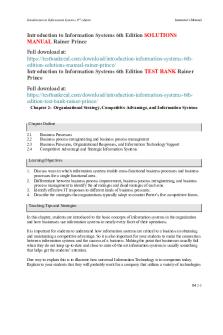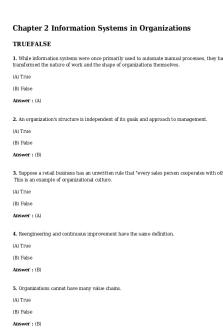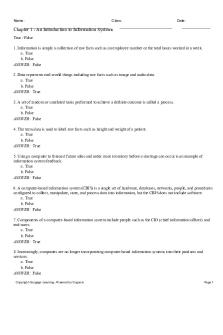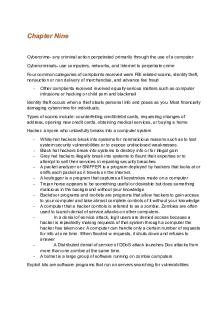Introduction to Information Systems 6th Edition Solutions Manual Rainer Prince PDF

| Title | Introduction to Information Systems 6th Edition Solutions Manual Rainer Prince |
|---|---|
| Author | Roaa Ahmed |
| Course | Introduction to information systems ch1-2 |
| Institution | Zagazig University |
| Pages | 19 |
| File Size | 261.8 KB |
| File Type | |
| Total Downloads | 34 |
| Total Views | 140 |
Summary
Summary ...
Description
Introduction to Information Systems, 6th edition
Instructor’s Manual
Introduction to Information Systems 6th Edition SOLUTIONS MANUAL Rainer Prince Full download at: https://testbankreal.com/download/introduction-information-systems-6thedition-solutions-manual-rainer-prince/ Introduction to Information Systems 6th Edition TEST BANK Rainer Prince Full download at: https://testbankreal.com/download/introduction-information-systems-6thedition-test-bank-rainer-prince/ Chapter 2: Organizational Strategy, Competitive Advantage, and Information Systems
Chapter Outline 2.1 2.2 2.3 2.4
Business Processes Business process reengineering and business process management Business Pressures, Organizational Responses, and Information Technology Support Competitive Advantage and Strategic Information Systems
Learning Objectives 1. 2. 3. 4.
Discuss ways in which information systems enable cross-functional business processes and business processes for a single functional area. Differentiate between business process improvement, business process reengineering, and business process management to identify the advantages and disadvantages of each one. Identify effective IT responses to different kinds of business pressures. Describe the strategies that organizations typically adopt to counter Porter’s five competitive forces.
Teaching Tips and Strategies In this chapter, students are introduced to the basic concepts of information systems in the organization and how businesses use information systems in nearly every facet of their operations. It is important for students to understand how information systems are critical to a business in obtaining and maintaining a competitive advantage. So it is also important for your students to make the connection between information systems and the success of a business. Making the point that businesses usually fail when they do not keep up-to-date and close to state-of-the-art information systems is usually something that helps get the students’ attention. One way to explain this is to illustrate how universal Information Technology is in companies today. Explain to your students that they will probably work for a company that utilizes a variety of technologies
IM 2-1
Introduction to Information Systems, 6th edition
Instructor’s Manual
at various levels of the organization. You might want to open your presentation for this chapter with a discussion about how information technology impacts many aspects of our life. Some examples are: ▪ ▪ ▪ ▪ ▪
ATM machines and banks in general. Grocery store checkout line cash registers with bar code scanners and the ability to use bankcards and credit cards for purchases. The ability of those grocery stores point-of-sale systems to also update the store’s inventory system in real-time. Your college or university relies on IT. The registrar’s office, financial aid office, and the library are just a few examples. Smartphones, tablets, and laptops.
Explain to your students how the various areas of your school use information technology to perform their tasks. Develop examples of how the office that handles administrative systems (i.e. registration/grades, financial aid, etc.) is usually on a different network, because this helps limit the number of users that can modify grades or view students’ records. Discuss why by properly managing their data network the school saves money and has the ability to control what information or programs students and faculty members can access. Then explain how companies use access controls to manage information stored on their network. For example, in most organizations, each user has a userID and pass code. They are usually linked to a level of security clearance, which limits what information the user can access. That access is based on a user’s need, which ensures that they can accomplish the work that they need to complete, yet cannot access other parts of the system. Many tasks that are performed by some employees are the same every week (such as recording hours worked for payroll) and that process can be automated including entering time sheets, calculating hours worked, etc. Discussing payroll related examples usually gets the students interested in information systems since it has a universal interest for all employees, whether they are an MIS major or not. Unfortunately, in today’s interconnected world we have access to so much information that it is often overwhelming for managers to know where the best data resides, and how to access it. Managers can see what products are selling and what products are not. This information can be used to better help management run the day-to-day operations of a business. This chapter is important in that it sets the foundation for the importance of information systems discussed through the rest of the book. Your students should begin to realize that this is important for them to understand and will use in their future careers. Your students need to understand that information technology not only change the way business is done, but it also helps the business share information and make better-educated decisions that will in turn help their business thrive in a competitive environment. The students should also be able to apply this knowledge to their specific major. It is important for students to understand that there is need for managers to understand what is involved with IT because of the interdependence that exists between the business and technology used. It is also important for you to emphasize that technology is evolving into open system standards. This means that industries now expect information technology solutions to be seamlessly interconnected and upgradeable. A good example of this the way the medical industry is automating patient records.
IM 2-2
Introduction to Information Systems, 6th edition
Instructor’s Manual
Businesses that can upgrade their systems can save millions of dollars not just on equipment costs, but save money by not having to retrain customers or employees on new system interfaces when they are implemented. This chapter should help your students to realize that when they or the business where the work is looking at adapting or changing technology they use, it is not as easy as just installing a piece of new hardware or a software program. They must consider and analyze future needs and make sure that the programs/technologies they are implementing will not only work today, but also be able to integrate with new technologies in the future. Blackboard/CMS suggestions
I again suggest that if you are teaching an online class or are looking for a short video for a lecture class, you can usually find a relevant topic videos at http://youtube.com. The problem is that sometimes they are product demos or sales videos, but they still usually present relevant information or concepts. Opening case: GrubHub
1. Look ahead in this chapter. Which one of Porter’s strategies for competitive advantage is GrubHub pursuing? Explain your answer. ANSWER: GrubHub’s strategy is to develop knowledge of the industry in order to integrate their system into the food service industry to limit the threat of entry of new competitors into their market space.. They are also using the bargaining power of customers by providing services (such as order/delivery tracking) to deferentiate themselves from their competition. Level: Easy Section/Learning Objective: Section 2.4 / Learning Objective 4 Bloom’s Category: Comprehension AACSB Category: Reflective Thinking 2. Propose additional applications that GrubHub could develop to gain a competitive advantage in the marketplace. ANSWER: Based on information presented in the case, GrubHub should consider developing mobile versions of their order and tracking applications. Students should be able to contribute additional ideas. Level: Easy Section/Learning Objective: Section 2.1 / Learning Objective 1 Bloom’s Category: Comprehension AACSB Category: Reflective Thinking
IM 2-3
Introduction to Information Systems, 6th edition
Instructor’s Manual
IT’s About Business - 2.1 NASCAR Uses IT in Its Pre-Race Inspection
1. Describe why pre-race inspection is a business process for NASCAR. ANSWER: It is a process that begins two days prior to the race. Each car that is entered in the race must go through and pass the inspection to compete. If the car does not pass NASCAR’s inspection on the first try, the team is permitted to fix the problem and go through a second inspection, which also requires the team to go to the back of the line. NASCAR also conducts post-qualifying and race-day inspections. NASCAR’s pre-race inspection process is considered a business process because racing is NASCAR’s business. So tracking everything in detail involved in the inspection process is important to a NASCAR race’s outcome. Level: Easy Section/Learning Objective: Section 2.1 / Learning Objective 1 Bloom’s Category: Comprehension AACSB Category: Reflective Thinking 2. Describe the various benefits that the app provides NASCAR. ANSWER: The benefits of NASCAR’s app include; - the app has simplified the pre-race inspection process - elimination of the paper-based forms previously required - The app uses a “default good” approach, requiring race officials to now note only those areas where violations are found. - Provides a method for the collection of data real-time. - The app provides a method to accumulate data that can be used to identify trends and patterns to maintain a level playing field. Level: Easy Section/Learning Objective: Section 2.1 / Learning Objective 1 Bloom’s Category: Knowledge AACSB Category: Reflective Thinking 3. Look ahead to Section 2.4. Is the app a strategic information system (SIS) for NASCAR? Why or why not? Support your answer. ANSWER: This could be considered a strategic information system for NASCAR. The system automates the previous paper-based system. This enables for the consistent tracking and long-term tracking of the data collected. This enables NASCAR to implement their strategic goals and improve the performance and productivity of those involved in the pre-race inspection process. Level: Medium Section/Learning Objective: Section 2.4 / Learning Objective 4 Bloom’s Category: Application
IM 2-4
Introduction to Information Systems, 6th edition
Instructor’s Manual
AACSB Category: Reflective Thinking IT’s About Business 2.2 BPR, BPI, and BPM at Chevron
1.
What was one of the main advantages of BPR at Chevron?
ANSWER: Chevron used a holistic approach to examine the interdependencies between processes executed in different business units. This ultimately improved the company’s overall performance. In a 1996 report, Chevron claimed that the BPR project saved the company $50 million. Level: Easy Section/Learning Objective: Section 2.2 / Learning Objective 2 Bloom’s Category: Comprehension AACSB Category: Reflective Thinking 2.
Why did Chevron adopt BPI?
ANSWER: In 1995, Chevron was less than half of its current size today, producing roughly 1 million barrels of oil per day across six plants. The company was divided into three major departments: Refining, Marketing, and Supply and Distribution (S&D). Management decided that they needed to improve their supply chain to better integrate their multiple internal processes. The company leadership decided the best strategy to dramatically improve performance of the company was to reengineer its end-to-end core processes, from the acquisition of crude oil crude through distribution of final products to Chevron customers. Level: Medium Section/Learning Objective: Section 2.2 / Learning Objective 2 Bloom’s Category: Application AACSB Category: Technology 3.
How does Chevron apply BPM in its operations today?
ANSWER: Chevron’s current BPM strategy is part of a larger companywide management system that focuses on operational excellence. The program requires all Chevron operating companies and business units to adopt a continuous improvement perspective, directed by guidelines, metrics, and targets that are reviewed and adapted every year. Apart from process efficiency, Chevron focuses on metrics related to safety, risk, and the environment. All employees participate in operational excellence activities, and managers receive specific operational excellence training to support the continuous improvement culture. Level: Medium Section/Learning Objective: Section 2.2 / Learning Objective 2 Bloom’s Category: Application AACSB Category: Reflective Thinking
IM 2-5
Introduction to Information Systems, 6th edition
Instructor’s Manual
IT’s About Business 2.3 Solar-Powered Tablets in Ethiopia
1. What advantages could result from increasing the literacy of 100 million children around the world? Be specific. ANSWER: The advantage of increasing the literacy of children around the world provides the means for those children to teach their parents what they have learned, providing a means for moving those adults towards literacy with their children. Level: Easy Section/Learning Objective: Section 2.2 / Learning Objective 2 Bloom’s Category: Knowledge AACSB Category: Reflective Thinking 2. In this experiment, the tablets were not connected to the Internet. Discuss the advantages and disadvantages to the children if the tablets were connected. ANSWER: Where the experiment was conducted, the availability of the Internet connectivity was either limited or non-existent. So to provide connectivity, that infrastructure would have to be built at some cost. Connectivity would open the world up to the children in the experiment. While this might give them some incentives to learn, it may also slow the process because it might reduce the incentive in some to explore the capabilities of table itself. Level: Medium Section/Learning Objective: Section 2.2 / Learning Objective 2 Bloom’s Category: Application AACSB Category: Reflective Thinking IT’s About Business 2.4 The Weather Channel
1. Identify several reasons (not discussed in the case) why accurate weather predictions are so important. Can an accurate weather prediction be considered a competitive advantage for an organization that receives this information? Why or why not? Support your answer with specific examples. ANSWER: Accurate weather forecasting can be considered a competitive advantage for many organizations. For example, truckers, may be alter routes if they know of a storm ahead of time. Local governments would be able to implement Emergency Management Plans if they had prior notice of severe weather approaching their community. Along those lines, local merchants might be able to have certain supplies brought in to have them on hand for the local community. Students should be able to come up with addition reasons. Level: Medium
IM 2-6
Introduction to Information Systems, 6th edition
Instructor’s Manual
Section/Learning Objective: Section 2.3 / Learning Objective 3 Bloom’s Category: Comprehension AACSB Category: Analytic 2. Will Dark Sky, Sky Motion, and WeatherSphere enjoy a lasting competitive advantage over The Weather Channel? Why or why not? Support your answer. ANSWER: As new competitors enter (and some of the older ones either leave or merge with others) TWC competitive advantage will continue to change. Another factor impacting TWC’s advantage is that based on 2015 cable viewership, customers are dropping cable TV service and moving to Internetbased streaming video services (discussed in a future chapter). Level: Medium Section/Learning Objective: Section 2.3 / Learning Objective 3 Bloom’s Category: Analysis AACSB Category: Reflective Thinking IT’s About Business 2.5 The University of Pittsburgh Medical Center Makes Effective Use of IT
1. Describe the strategic advantages that IT provides to UPMC. ANSWER: The strategic advantages that IT provides UPMC include developing applications and processes improving operations of UPMC’s hospitals and health insurance plan, enhance patient care, and drive down company costs. Level: Easy Section/Learning Objective: Section 2.4 / Learning Objective 4 Bloom’s Category: Comprehension AACSB Category: Reflective Thinking 2. Which of Porter’s competitive strategies is UPMC employing? Support your answer. ANSWER: UPMC is employing the following strategies. 1. Innovation strategy.. rather than use off-the-shelf applications, the Technology Development Center developed new application to fill needs, such as Virtual Care Collaboration system. 2. operational effectiveness strategy.. they used the massive amount of data they collected for data analytics for a number of studies of current processes and patient procedures.. 3. customer orientation strategy.. by automating some of the reporting processes the doctor’s had to perform Level: Medium Section/Learning Objective: Section 2.3 / Learning Objective 3 Bloom’s Category: Application AACSB Category: Reflective Thinking 3. Describe how UPMC illustrates effective business–IT alignment.
IM 2-7
Introduction to Information Systems, 6th edition
Instructor’s Manual
ANSWER: When the business could not find an off-the-shelf system to meet their needs, they made the decision to develop the system in-house. An example of this is their Virtual Care Collaboration system. Level: Easy Section/Learning Objective: Bloom’s Category: Application AACSB Category: Reflective Thinking Review Questions - Before You Go On...
Section 2.1 … 1. What is a business process? ANSWER: A business process is an ongoing collection of related activities that create a product or a service of value to the organization, its business partners, and/or its customers. A process has inputs and outputs, and its activities can be measured. Many processes cross functional areas in an organization. For example, product development involves research, design, engineering, manufacturing, marketing, and distribution. Level: Easy Section/Learning Objective: Section 2.1 / Learning Objective 1 Bloom’s Category: Knowledge AACSB Category: Technology 2. Describe several business processes carried out at your university. ANSWER: These include Accounts receivable (tuition), registration, payroll, human resources, etc… Level: Medium Section/Learning Objective: Section 2.1 / Learning Objective 1 Bloom’s Category: Knowledge AACSB Category: Technology 3. Define a cross-functional business process, and provide several examples of such processes. ANSWER: This is a process in which no single functional area is responsible for its completion; multiple functional areas collaborate to perform the function. Level: Application Section/Learning Objective: Section 2.1 / Learning Objective 1 Bloom’s Category: Knowledge AACSB Category: Technology
IM 2-8
Introduction to Information Systems, 6th edition
4.
Instructor’s Manual
Pick one of the processes described in questions 2 or 3 given above, identify its inputs, outputs customer(s), and resources. How does the process create value for its customers?
ANSWER: Students will contribute responses depending on the process they choose. Level: Medium Section/Learning Objective: Section 2.1 / Learning Objective 1 Bloom’s Category: Application AACSB Category: Reflective Thinking Section 2.2 … 1.
What is business process reengineering?
ANSWER: A strategy for improving the efficiency and effectiveness of an organization’s business processes. The key to BPR is for enterprises to examine their business processes from a “clean sheet” perspective and then determine how they can best reconstruct those processes to improve their business functions. Level: Easy Section/Learning Objective: Section 2.2 / Learning Objective 2 Bloom’s Category: Knowledge AACSB Category: Technology 2.
What is business process improvement?
ANSWE...
Similar Free PDFs
Popular Institutions
- Tinajero National High School - Annex
- Politeknik Caltex Riau
- Yokohama City University
- SGT University
- University of Al-Qadisiyah
- Divine Word College of Vigan
- Techniek College Rotterdam
- Universidade de Santiago
- Universiti Teknologi MARA Cawangan Johor Kampus Pasir Gudang
- Poltekkes Kemenkes Yogyakarta
- Baguio City National High School
- Colegio san marcos
- preparatoria uno
- Centro de Bachillerato Tecnológico Industrial y de Servicios No. 107
- Dalian Maritime University
- Quang Trung Secondary School
- Colegio Tecnológico en Informática
- Corporación Regional de Educación Superior
- Grupo CEDVA
- Dar Al Uloom University
- Centro de Estudios Preuniversitarios de la Universidad Nacional de Ingeniería
- 上智大学
- Aakash International School, Nuna Majara
- San Felipe Neri Catholic School
- Kang Chiao International School - New Taipei City
- Misamis Occidental National High School
- Institución Educativa Escuela Normal Juan Ladrilleros
- Kolehiyo ng Pantukan
- Batanes State College
- Instituto Continental
- Sekolah Menengah Kejuruan Kesehatan Kaltara (Tarakan)
- Colegio de La Inmaculada Concepcion - Cebu






![OBrien - Introduction to Information Systems [2010]](https://pdfedu.com/img/crop/172x258/zx28ke2j06rw.jpg)








